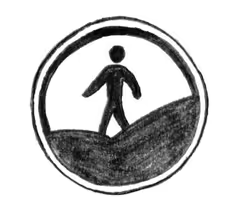Access All Areas
Share this page

In the summer of 2020 I began swimming (I decline to add the unnecessary prefix ‘wild’ because, as my Aussie friend always points out, it is after all just swimming) in a whole series of new places. Until then I’d assumed there were only two good swimming spots in the valley, both of which had become overrun long before Covid-19. I went in Gaddings Dam occasionally early or late in the day or the season, but never on a hot day in summer, and I had long since abandoned the dark hole of Lumb Falls to the local kids bombing from the top of the waterfall.
Soon after the first lockdown ended I heard whispers of other disused dams where you could swim, and, in the heat of late spring, was eager to end as many runs as possible at these sites. They were wonderful oases, where you could change quietly alone and slip into the undisturbed water. Yet, no sooner had my friends and I declared a new favourite, the landowner put up a ‘Private’ sign. Apparently we weren’t alone in discovering this gem, as the empty vodka bottles left on the grass around the dam attested. Changing behind the dam wall and sneaking into the water took much of the charm out of this activity, and I cursed myself for not having found this place sooner. We moved on to the next, more distant dam and declared this even better, a larger expanse with no farm overlooking the site. Yet within weeks this too had become popular and on hot days at the height of summer it was starting to look more like Gaddings, with cars clogging the tiny lanes nearby. The third site, now our favourite, never hit these heights, although I have heard tales of groups being kicked out. We took to meeting late on summer evenings for a run and a swim, and it was paradise to plunge into the dark water, a rare highlight in a tumultuous year.

There is an eternal conundrum here, of wanting to discover these ‘secret’ places and then wanting to have them yourself, to keep them secret. My motivation for this was not because I didn’t want to share these delights, however, but rather because I knew that if others followed, our pleasures would inevitably be curtailed. All of these swimming places are in small dams built in the 18th or 19th centuries to supply water for nearby mills. They are no longer used for this or for drinking water, but they remain private property, often by a reluctant landowner whose main concern is liability. While they may be happy to overlook the occasional swimmer, they don’t want their property to turn into a festival site. It is hard to blame them – the state of the area around Lumb Falls has been a disgrace this past year, and understandably the landowners fear a repeat of this. As people have turned their attention to the local landscape in the past year, this has become an increasingly common occurrence, with an inevitable confrontation between landowners and the public.
It is something I’ve also encountered on routes that I have advocated in my books. I have always tried to uncover the smaller, less frequented paths and love encouraging others to explore them. However, many of these, particularly in the woods, are informal and legally unrecognised routes through private woodland. I had not had many problems until 2020, when similar paths on three of my routes were blocked off within a few months of each other. Barbed-wire fences, barricades, rebuilt walls and ‘Private property’ signs all appeared, and people complained to me that they could no longer follow my routes. These were all technically private though, so there was no recourse other than to create an alternative route for future editions.
Covid-19 has brought a lot more people into these woods, whether following my guide or not, and these small paths have become increasingly well trodden until the landowners have had enough. It is a worrying pattern, particularly as, after 2026, we won’t be able to claim any of these well-used routes as Public Rights of Way. Over half of our woodland is privately owned, though much of it is unmanaged and uncared for, much like those old dams on the moor. Local people have begun exploring these areas and creating new paths, and their activity is largely ignored until the weight of it becomes too much.
Mountain biking has had similar issues in the woods near my home; where an informal agreement between the local club and landowner existed when a few local bikers were creating a small number of routes through the trees. But, as soon as the area became publicised through magazines, forums and Strava, bringing groups from further afield to create new routes of their own, the landowner promptly blocked all access.
Maybe the problem is a fundamental issue with our access laws, or maybe we are just too crowded a small island, but there is no doubt that Covid-19 has brought this, like many other issues, to the fore.

